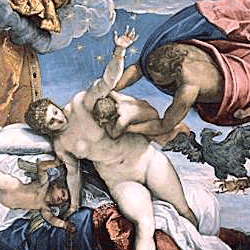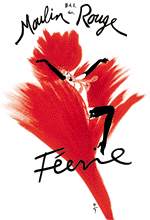Art in Paris – Tintoretto

- SUBSCRIBE
- ALREADY SUBSCRIBED?
BECOME A BONJOUR PARIS MEMBER
Gain full access to our collection of over 5,000 articles and bring the City of Light into your life. Just 60 USD per year.
Find out why you should become a member here.
Sign in
Fill in your credentials below.
 Art in Paris – Tintoretto and the contest for the decoration of the Council Room of the Doge’s Palace in Venice
Art in Paris – Tintoretto and the contest for the decoration of the Council Room of the Doge’s Palace in Venice
The Doge of Venice was elected for life, to lead the oligarchic government of that city. His post was the most important civic post in the city. His seat of power, the Doge’s Palace, abuts St. Mark’s Square next to the seat of ecclesiastical power, the church of San Marco.
It is important to realize that despite the religious nature of most Italian Renaissance art, both the city and the church acted as patrons of the arts. In fact, the history of Italian Renaissance art is studded with civic patronage that has left us with brilliant examples of artistic endeavor. Donatello, Nanni di Banco, and Ghiberti helped to fill the niches on the meeting hall of the guilds in Florence. The city of Florence gave commissions to Leonardo and Michelangelo for frescos to decorate the Palazzo Vecchio, which unfortunately have been destroyed.
In the fourteenth century Venice contracted with Guariento, a Paduan painter, to decorate the Room of the Grand Council, with a fresco for the wall behind the throne of the Doge. That painting depicted the Coronation of the Virgin, a theme favored in Byzantine-influenced Venice, but known by the populus as Il Paradiso, Paradise. Guariento’s work was destroyed in a fire in 1577.
The decision to rebuild and redecorate was immediate. It was an opportunity to modernize the décor, and as Venice was replete with artistic ateliers, it was decided to hold a competition for the commission.
It was not uncommon that artistic commissions were the result of a competition. For example, in Florence, Ghiberti went up against Brunelleschi and two others for the design of the Baptistery doors in 1403. Two of the bronze competition panels for the doors in Florence have been preserved and are exhibited in the galleries of the Academia in that city.
But we seldom have a chance to second-guess the judges because the losing entries have not come down to us. Now, thanks to a team of curators from Venice and the Louvre, we get a chance to see the entries in a Venetian competition. Five of the most established of the city’s artists were asked to submit oil sketches on canvases proportionate to the wall on which the painting was to hang. The assigned  subject was Paradise. The Louvre exhibition gives us the paintings submitted by four artists; Tintoretto, Palma the Younger, Francesco Bassano, and Veronese. In the case of Tintoretto, preliminary drawings for individual figures have been strategically placed in front of the oil sketches.
subject was Paradise. The Louvre exhibition gives us the paintings submitted by four artists; Tintoretto, Palma the Younger, Francesco Bassano, and Veronese. In the case of Tintoretto, preliminary drawings for individual figures have been strategically placed in front of the oil sketches.
The canvases have aged poorly and are not in a wonderful state of preservation. One can hardly blame the Venetians for not expending money on these particular pieces of painted linen. They have far more important pictures to preserve. However, you can still see what the judges saw, how the compositions differ, and how each artist approached the given theme of “Paradise”.
The most traditional, or perhaps old-fashioned, approach to the subject is by Frederico Zuccaro, who arranged his myriad figures in parallel semi-circles. It is more in keeping with a Last Judgment than Paradise itself after the moment of judgment. Tintoretto’s sketch has more randomly placed groups of people more in the vein of Michelangelo’s Last Judgment; i.e., less regimented and less medieval and hieratic in character.
This show would make a top-notch graduate school seminar report, and as such it is really an exhibition for specialists and inamorati of Baroque Venetian art. It may not be for the general public.
Another word of caution: the name of the winning artist is confusingly different in French and in English. Many of the readers of Art in Paris are equally at ease in French and English and will read the didactic labels in French. Be warned that the artist Jacopo Robusti, known in English as Tintoretto, and in Italian as Tintoretto, is called Tintoret in French. His son, Dominique Tintoretto is called Tintoretto in French and Dominique Tintoretto in English so as to distinguish him from his more famous father. It was the famous and accomplished father, Tintoretto, the French Tintoret, who won the contest. According to the most recent research as reported in this exhibition, his son Domenico did most of the actual painting and made significant changes to the winning composition. This is an important finding for scholars of sixteenth-century Venetian art and is reason enough to mount this exhibition. But it may not be enough of a reason for you to see it.
Bottom line: The show is of modest interest to the casual viewer of Renaissance art, but taken in context, may be enlightening to those who love the city of canals.
At the Louvre until May 8th. Same hours as the Museum – every day but Tuesday 9- 6 pm, late to 10 pm on Wed. and Fri. Metro: Palais Royal/Musee du Louvre.
Deb Markow’s website is www.artalks.com
Copyright © Deb Markow


